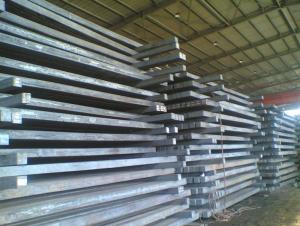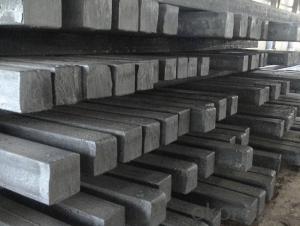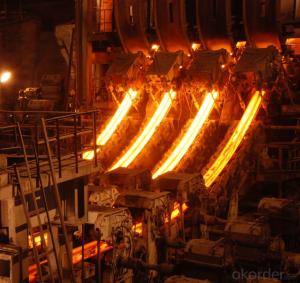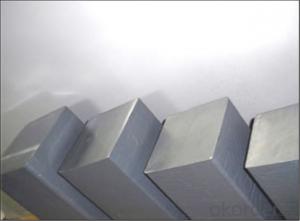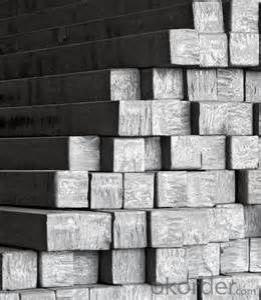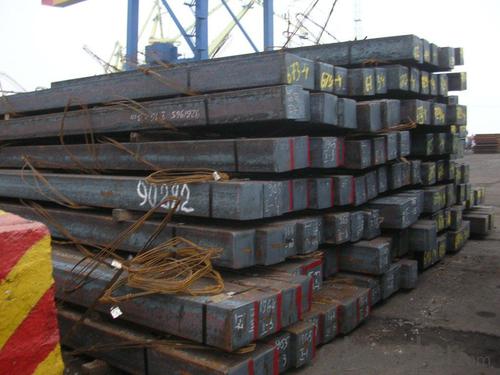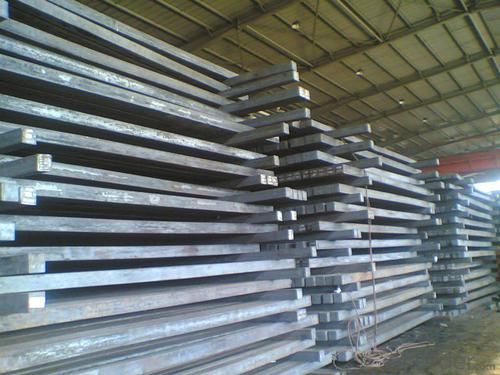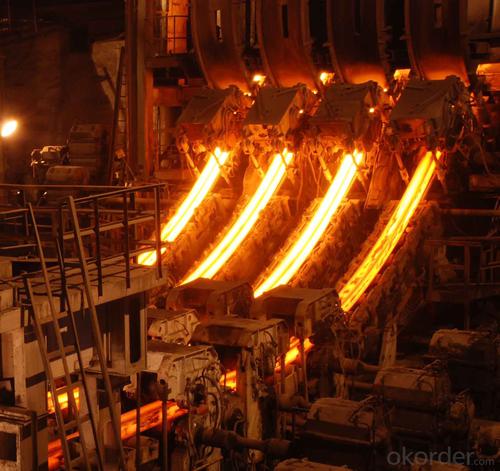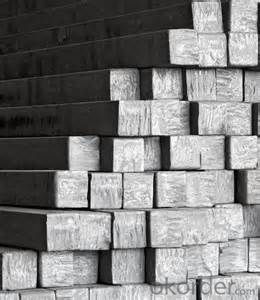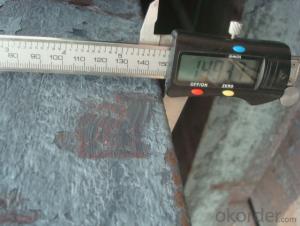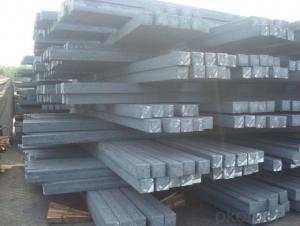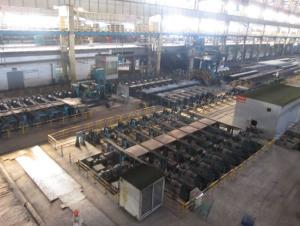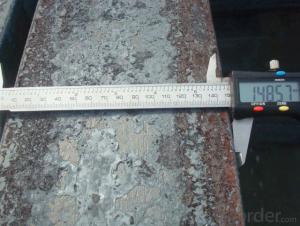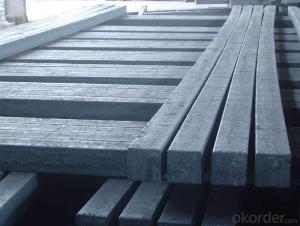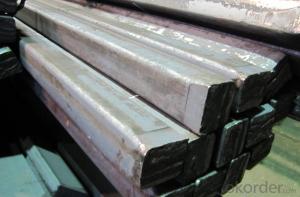Square Steel Billet Q235 3SP Grade Prime Quality 12#
- Loading Port:
- Tianjin
- Payment Terms:
- TT OR LC
- Min Order Qty:
- 2000 m.t
- Supply Capability:
- 50000 m.t/month
OKorder Service Pledge
OKorder Financial Service
You Might Also Like
Description of Square Steel Billet Q235 3SP Grade Prime Quality 12#
M. S. Billets are used for rolling of TMT Re-Bars of Fe415 and Fe500 Grade and various other structural steel products.
CRS Billets are used for rolling of CRS TMT Re-Bars.
Special Alloy Billets are used for rolling of any special grade TMT Re-Bars like Earthquake resistant TMT Re-Bars and for special grade structural steel products.
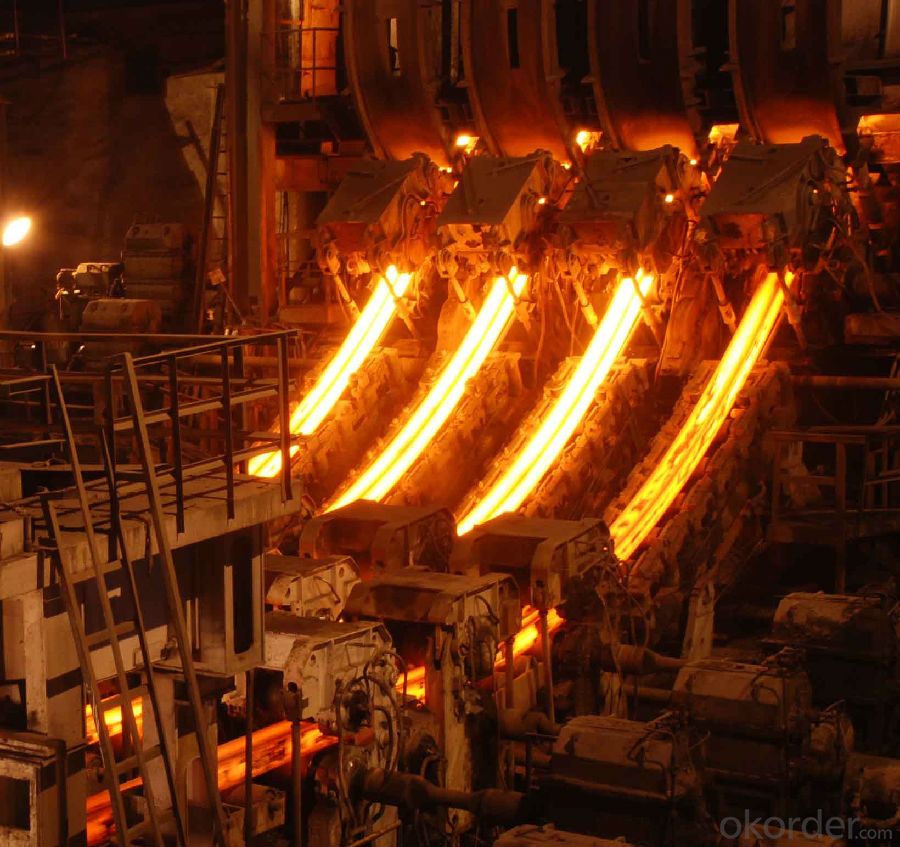
Main Feature Square Steel Billet Q235 3SP Grade Prime Quality 12#
Raw elements(C,Fe,Ni,Mn,Cr,Cu.)---Smelted ingots by AOD finery---hot rolled into black suface---pickling in acid liquid---cold drawn----polished by automatically machine--- cutting into pieces---checking quanlity
Applications of Square Steel Billet Q235 3SP Grade Prime Quality 12#
Widely Used in the areas such as Stainless Steel Fasteners, Chains, Kitchen and Sanitary wares, Furniture handles, Handrails, Electroplating and Electrolyzing pendants, Foods, Electron, Petroleum, Construction and Decoration, etc. Products have a high strength after cold-working. Electronic products parts, Medical appliance, Springs, Bus Inside and Outside packaging and building, Street Lamp Posts, etc. Decoration materials and Outdoor Publicity Billboard. Used for the products which have the Anti-Stress Corrosion requirement. Electron Products, Table-wares, Bolts, Nuts, Screen Meshes, Cumbustors and so on.
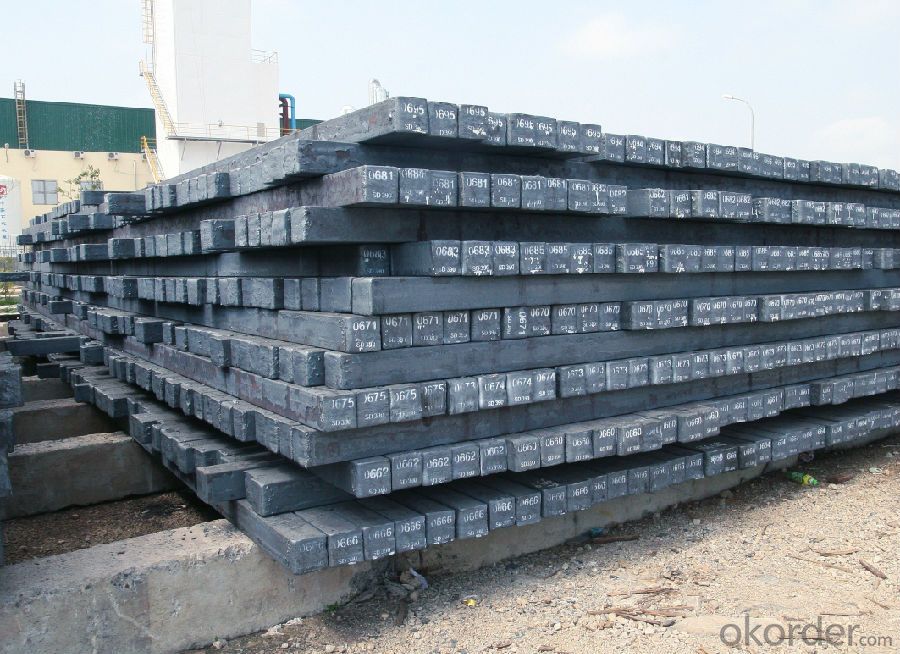
Specifications of Square Steel Billet Q235 3SP Grade Prime Quality 12#
| Standard | C(%) | Mn(%) | S(%) | P(%) | Si(%) |
| Q195 | ≤0.12 | ≤0.50 | ≤0.040 | ≤0.035 | ≤0.30 |
| Q235 | ≤0.20 | ≤1.40 | ≤0.045 | ≤0.045 | ≤0.35 |
| Q275 | ≤0.22 | ≤1.50 | ≤0.045 | ≤0.045 | ≤0.35 |
| 20MnSi | 0.17-0.25 | 1.2-1.6 | ≤ 0.050 | ≤ 0.050 | 0.40-0.80 |
| 3SP | 0.14-0.22 | 0.40-0.85 | ≤ 0.050 | ≤ 0.040 | 0.05-0.15 |
| 5SP | 0.28-0.37 | 0.50-1.00 | ≤ 0.050 | ≤ 0.040 | 0.15-0.30 |
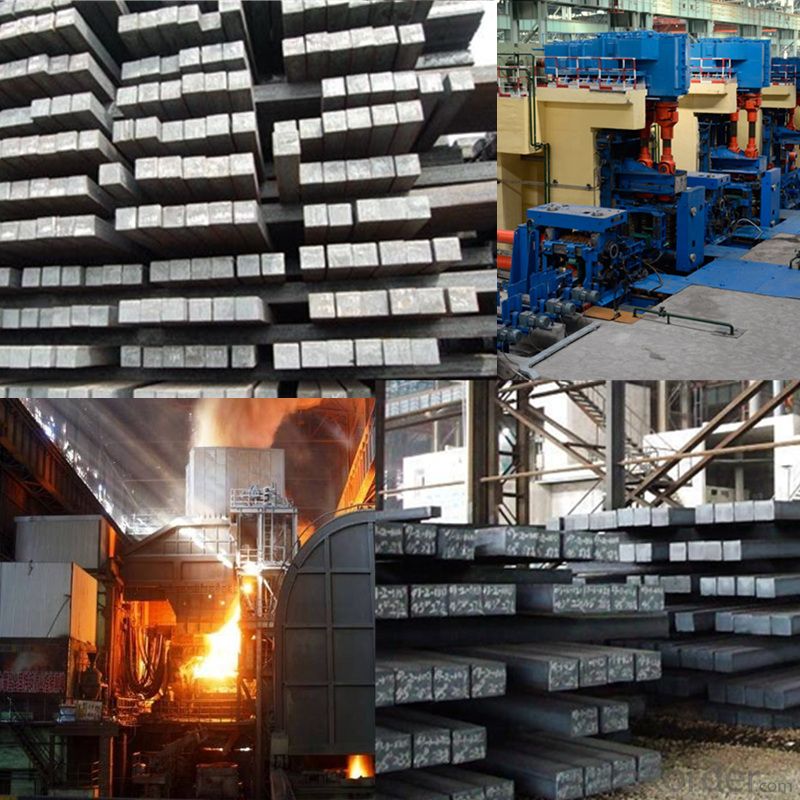
FAQ of Square Steel Billet Q235 3SP Grade Prime Quality 12#
We have organized several common questions for our clients,may help you sincerely:
1. How Can I Visit There?
Our company is located in Tianjin City, China, near Beijing. You can fly to Tianjin Airport Directly. All our clients, from home or aboard, are warmly welcome to visit us!
2. How Can I Get Some Sample?
We are honored to offer you sample.
3. Why choose CNBM?
Our delivery time about 15-20days for standard sizes, if you have other requirements like hardness, quanity and width ,it is about 20-40days. But don't worry we also try our best for the delivery time ,because time longer and our cost is higher.
- Q: Can steel billets be used in the automotive industry?
- Yes, steel billets can be used in the automotive industry. Steel billets are semi-finished steel products that are typically used for further processing into different shapes and forms. In the automotive industry, steel billets are commonly used for the production of various automotive components such as engine parts, transmission parts, chassis components, and suspension systems. The use of steel billets in the automotive industry offers several advantages including high strength, durability, and cost-effectiveness. Additionally, steel billets can be easily formed, machined, and welded to meet specific design requirements and performance standards in the automotive sector. Therefore, steel billets play a crucial role in the manufacturing of automobiles and contribute to the overall performance, safety, and reliability of vehicles.
- Q: How are steel billets used in the production of heat exchangers?
- Steel billets are an essential component in the production of heat exchangers. Heat exchangers are devices that transfer heat between two or more fluids, such as air and water, without them coming into direct contact. Steel billets, which are semi-finished metal products, serve as the raw material for manufacturing the various components of heat exchangers. Firstly, steel billets are used to create the tubes and pipes that form the primary framework of heat exchangers. These tubes are designed to withstand high pressures and temperatures while efficiently transferring heat. Steel, with its high strength and thermal conductivity, is an ideal material for this purpose. Next, the steel billets are processed through various techniques such as hot rolling, forging, or extrusion to shape them into the required dimensions. This process ensures that the tubes and pipes have the desired diameter, thickness, and length, which are crucial factors in determining the heat transfer efficiency of the heat exchanger. Additionally, steel billets are also used to produce the fins and plates of heat exchangers. Fins are thin, elongated structures that increase the surface area of the heat exchanger, allowing for enhanced heat transfer. Steel billets are shaped and cut into fins, which are then attached to the tubes or plates. These fins provide additional contact points for heat transfer and help improve the overall efficiency of the heat exchanger. Moreover, steel billets are used in the production of headers and manifolds, which are crucial components for the distribution and collection of fluids within the heat exchanger. These headers ensure that the fluids flow through the tubes and fins in a controlled manner, maximizing heat transfer and minimizing pressure losses. The strength and durability of steel make it a suitable material for these critical components. In conclusion, steel billets play a vital role in the production of heat exchangers. They are used to manufacture the tubes, pipes, fins, headers, and manifolds, which are all essential components of a heat exchanger. The use of steel ensures the durability, strength, and thermal conductivity required for efficient heat transfer in these devices.
- Q: Can steel billets be used in the production of medical equipment?
- Yes, steel billets can be used in the production of medical equipment. Steel is known for its strength, durability, and resistance to corrosion, making it an ideal material for manufacturing various medical devices. Steel billets, which are the initial semi-finished product of steel production, can be further processed and shaped into specific components or parts required for medical equipment. These components can include surgical instruments, implants, orthopedic devices, needles, and other medical tools. Steel's mechanical properties and ability to withstand sterilization processes make it a suitable choice for producing safe and reliable medical equipment.
- Q: What are the common sizes and shapes of steel billets?
- Steel billets are typically manufactured in various sizes and shapes to cater to the diverse needs of different industries. The most common sizes of steel billets range from 100mm to 200mm in width and 100mm to 300mm in height. However, it is important to note that these dimensions can vary based on the specific requirements of the end-user or the steel manufacturer. In terms of shapes, steel billets are commonly produced in rectangular or square shapes. Rectangular billets have flat and smooth surfaces with four right angles, while square billets have equal sides with four right angles as well. These shapes are preferred because they facilitate easier handling, transportation, and further processing of the steel billets. Additionally, steel billets can also be produced in other shapes such as round, hexagonal, or octagonal, depending on the intended application. These non-traditional shapes are often utilized in specialized industries like automotive or aerospace manufacturing, where unique geometries are necessary to meet specific design requirements. It is worth mentioning that the sizes and shapes of steel billets can vary across different regions and industries, as each may have their own specific standards and preferences. Therefore, it is important for manufacturers and end-users to communicate and align their requirements to ensure the production of steel billets that meet their respective needs.
- Q: What do you mean by adding carbon to a table tennis racket?
- The addition of carbon fibers increases the elasticity of the racket so as to increase the strength of the strike ball
- Q: Charcoal classification
- Hard charcoal. By hardwood such as Fagaceae Quercus, Castanopsis trees, secondary birch and etc..Broad-leaved charcoal. Charcoal made from a mixture of hard and soft hardwood.Pine charcoal. Carbon fired from pine or other needle wood. In addition to bamboo and bamboo charcoal burning with shells, stones (coconut shell, peach stone charcoal etc.) wood raw material firing. Charcoal collected from household stoves in the cell known as carbon. If the charcoal is crushed and mixed with proper adhesive, and then pressed, formed and roasted, the deposit is made. According to the burning process of silica and carbon black.
- Q: How are steel billets used in the production of industrial pumps?
- Steel billets are used in the production of industrial pumps as they serve as the raw material for creating the pump's main components, such as the pump body and impeller. These billets are melted, cast, and then forged or machined into the desired shapes and sizes to form the pump's robust and durable structure.
- Q: What is the role of steel billets in the construction of railway stations?
- Steel billets are essential in constructing railway stations, serving as semi-finished steel products that are typically rectangular or square in shape. They function as raw materials for various construction purposes. Within the realm of railway stations, steel billets are primarily utilized to fabricate structural components like beams, columns, and trusses. These components provide the necessary strength and stability to support the weight of the station building, platforms, and any associated structures. A key advantage of employing steel billets in railway station construction lies in their high strength-to-weight ratio. Steel is widely recognized for its exceptional strength, making it an ideal material for supporting heavy loads. By incorporating steel billets, engineers can design and construct railway stations capable of enduring the constant traffic and heavy footfall characteristic of these public spaces. Furthermore, steel billets offer exceptional durability, corrosion resistance, and fire resistance, all of which are vital factors in ensuring the long-term safety and structural integrity of railway stations. These properties establish steel billets as a reliable and cost-effective choice for construction projects prioritizing safety and longevity. Moreover, steel billets can be easily shaped and fabricated into various sizes and dimensions, allowing for flexibility in design and construction. This versatility enables architects and engineers to create aesthetically appealing and functional railway station structures tailored to the specific project requirements. In summary, steel billets play a crucial role in railway station construction by providing the necessary strength, durability, and versatility required for the structural components supporting these vital transportation hubs. By utilizing steel billets, railway station construction projects can be completed efficiently, guaranteeing the safety and comfort of passengers for years to come.
- Q: What are the different types of casting processes used for shaping steel billets?
- There are several different types of casting processes used for shaping steel billets. These processes include: 1. Continuous Casting: This is the most commonly used method for casting steel billets. In this process, molten steel is poured into a water-cooled mold that is continuously moving. As the steel solidifies, it is continuously pulled out of the mold, resulting in a continuous billet. This process is efficient and allows for high production rates. 2. Centrifugal Casting: In this process, molten steel is poured into a rotating mold. The centrifugal force generated by the rotation distributes the molten metal evenly along the mold walls, resulting in a cylindrical billet. This method is used to produce high-quality and defect-free billets. 3. Ingot Casting: This is a traditional method of casting steel billets. In this process, molten steel is poured into a mold and allowed to solidify. The solidified steel, known as an ingot, is then removed from the mold and further processed to obtain the desired shape of the billet. Ingot casting allows for flexibility in terms of billet shape and size. 4. Sand Casting: This process is used for producing large and complex steel billets. It involves creating a mold using a mixture of sand and a binder material. Molten steel is then poured into the mold, and once it solidifies, the mold is removed to reveal the billet. Sand casting allows for the production of custom-shaped billets but is a slower and less precise process compared to others. 5. Investment Casting: Also known as lost-wax casting, this process is suitable for complex and intricate shapes. In investment casting, a wax pattern of the desired billet shape is created. The wax pattern is then coated with a ceramic shell, and the wax is melted out, leaving behind a hollow mold. Molten steel is poured into the mold, and once it solidifies, the ceramic shell is broken to retrieve the billet. Each of these casting processes has its advantages and disadvantages, and the choice of process depends on factors such as the desired billet shape, size, production volume, and quality requirements.
- Q: What is the role of steel billets in the manufacturing of material handling equipment?
- Steel billets play a crucial role in the manufacturing of material handling equipment as they serve as the primary raw material for forging and shaping various components. These billets are heated, molded, and transformed into different parts such as frames, beams, brackets, and supports, which provide strength, durability, and stability to the equipment. Additionally, steel billets ensure the structural integrity and load-bearing capacity of the material handling equipment, enabling them to withstand heavy loads and rigorous operational conditions.
Send your message to us
Square Steel Billet Q235 3SP Grade Prime Quality 12#
- Loading Port:
- Tianjin
- Payment Terms:
- TT OR LC
- Min Order Qty:
- 2000 m.t
- Supply Capability:
- 50000 m.t/month
OKorder Service Pledge
OKorder Financial Service
Similar products
Hot products
Hot Searches
Related keywords

